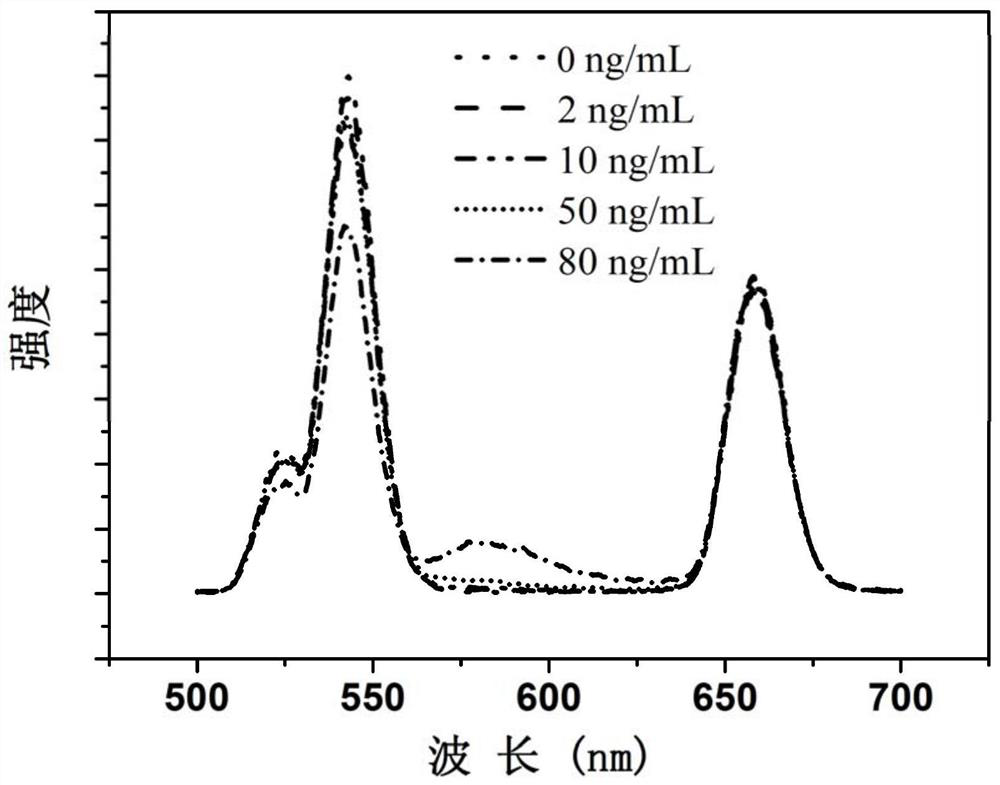A solid-state up-conversion fluorescent probe and its preparation method and application
A fluorescent probe and solid-state technology, applied in the field of chemical detection, can solve the problems of low luminous efficiency of up-conversion nanoparticles, affecting the sensitivity and detection limit of biological detection, and low luminous efficiency
- Summary
- Abstract
- Description
- Claims
- Application Information
AI Technical Summary
Problems solved by technology
Method used
Image
Examples
Embodiment 1
[0027] Example 1 Preparation of solid-state up-conversion fluorescent probe and its use in the detection of carcinoembryonic antigen (CEA)
[0028] Disperse the PMMA microspheres in water, insert the glass substrate vertically into the turbid liquid of PMMA microspheres, and then place it in an oven at 28°C for 30 hours. The PMMA microspheres were assembled on the glass substrate orderly by the surface tension during the solution volatilization process. Then, the PMMA photonic crystal was placed in an oven at 120 °C for 40 min to increase its mechanical strength.
[0029] 0.4g polyetherimide (PEI), 2.5mmolNaCl, 0.798mmolY (NO 3 ) 3 , 0.2mmol Yb(NO 3 ) 3 and 0.002mmol Tm(NO 3 ) 3 Place in a beaker, add 15ml ethylene glycol and stir well, weigh 4mmol NH 4 F powder in another beaker, add 10ml ethylene glycol, and stir; when the two samples are stirred to a clear solution, add the latter dropwise to the former and continue to stir until clarified and put into the reaction k...
Embodiment 2
[0033] Example 2 Preparation of solid-state up-conversion fluorescent probe and its use in the detection of carbohydrate antigen (CA-125)
[0034] Disperse the PS microspheres in water, then insert the glass slide vertically into the turbid solution of PS microspheres, and then place it in an oven at 32°C for 24 hours. The PS microspheres were assembled on the glass substrate orderly by the surface tension during the solution volatilization process. Then, the PS photonic crystal was placed in an oven at 110 °C for 40 min to increase its mechanical strength.
[0035] 0.4g polyetherimide (PEI), 2.5mmolNaCl, 0.78mmolY(NO 3 ) 3 , 0.2mmol Yb(NO 3 ) 3 and 0.02mmol Er(NO 3 ) 3 Place in a beaker, add 15ml ethylene glycol and stir well, weigh 4mmol NH 4 Put F powder in another beaker, add 10ml of ethylene glycol, and stir; when the two samples are stirred to a clear solution, add the latter dropwise to the former and continue stirring for 10 minutes, then put it into the reactio...
Embodiment 3
[0040] SiO 2 The microspheres were dispersed in water, and then the glass slide was inserted vertically into the SiO 2 The turbid solution of the microspheres was then placed in an oven at 40°C for 20 hours. The surface tension of SiO during solution volatilization 2 The microspheres are orderedly assembled on the glass substrate. Then, the SiO 2 The photonic crystals were placed in an oven at 100°C for 60 min to increase their mechanical strength.
[0041] 0.4g polyetherimide (PEI), 2.5mmolNaCl, 0.79mmolY(NO 3 ) 3 , 0.18mmol Yb(NO 3 ) 3 and 0.03mmol Er(NO 3 ) 3 Place in a beaker, add 15ml ethylene glycol and stir well, weigh 4mmol NH 4 Put F powder in another beaker, add 10ml of ethylene glycol, and stir; when the two samples are stirred to a clear solution, add the latter dropwise to the former and continue to stir for 10 minutes, then put it into the reaction kettle, and react 2 samples at 240°C Hours, after the reaction kettle was naturally cooled to room temper...
PUM
 Login to View More
Login to View More Abstract
Description
Claims
Application Information
 Login to View More
Login to View More - R&D
- Intellectual Property
- Life Sciences
- Materials
- Tech Scout
- Unparalleled Data Quality
- Higher Quality Content
- 60% Fewer Hallucinations
Browse by: Latest US Patents, China's latest patents, Technical Efficacy Thesaurus, Application Domain, Technology Topic, Popular Technical Reports.
© 2025 PatSnap. All rights reserved.Legal|Privacy policy|Modern Slavery Act Transparency Statement|Sitemap|About US| Contact US: help@patsnap.com



